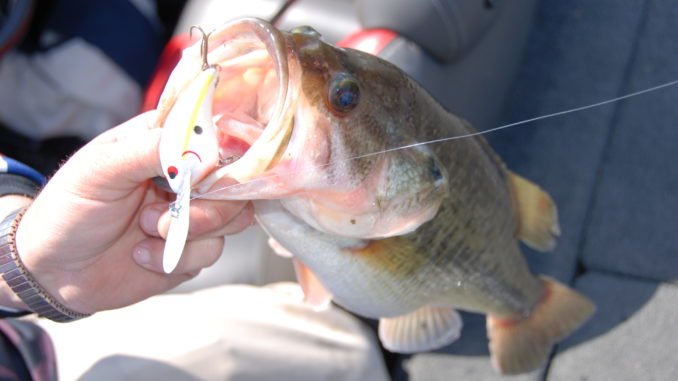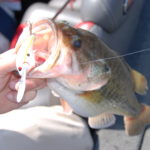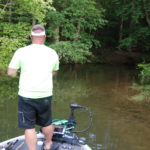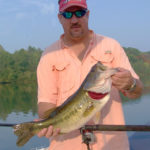
Fishing at this Saluda River reservoir can be excellent for anglers willing to brave the heat for some big bass — shallow and deep.
Many of the die-hard bass fishermen who call Lake Greenwood home or rank it among their top lakes would likely classify August as their least-favorite month to fish. It’s hot, and the recreational boat traffic reaches a crescendo in the last month of summer vacation.
August may not be his favorite month, but Paul Gettys of Due West, a bass pro and fishing guide, said it certainly it certainly isn’t to be avoided. When he chooses between Greenwood or any of the nearby lakes on the Savannah River — Hartwell, Russell or Clarks Hill — he takes Greenwood every time because of the chance to catch big bass on a topwater frog bait and the availability of cover on the 11,400-acre lake.
Dan Rankin, a fisheries biologist with the S.C. Department of Natural Resources, thinks Gettys is on target, especially where big bass are concerned.
“Our recent surveys on Greenwood have shown that the lake has a good population of largemouth bass, and some very plump fish,” he said. “Greenwood has always been a fertile lake with an abundance of forage, which may account for why some anglers struggle there. Most of what we have found (as far as) good fish was around deep structure, out away from the banks where not as many anglers look for them.”
Rankin also said that Greenwood ranks high in his ranking of bass lakes in the Upstate based on the number of fish that his department sees during their electroshocking surveys.
“Greenwood produces good numbers of nice, chunky bass although in years past it has received and still sees a lot of angling pressure. (It) is a very fertile system, and its fish-growing potential continues,” he said. “One of the best things to happen at Greenwood over the last decade was when the state reduced the creel limit to five fish. Most of the tournament guys rarely keep any fish, but that reduction for the recreational anglers has apparently helped the lake a good bit.”
Gettys fishes two main patterns at Greenwood this month.
He looks for shallow fish in areas where there is ample food and sustainable water quality. He’s looking for what he calls “resident fish” — they move into these places and stay put, but when you catch one and remove it, it’s not replaced for three to four days.
“You’re always going to have those fish that stay shallow year- round,” he said. “Those fish find a constant food source and they locate suitable water, and they stay there.”
Next, he looks in deep water for fish that are constantly moving to and from structure, where new fish may move in on an hourly basis.
“By late July and August, the majority of the fish are moving out to the deeper water to find structure,” Gettys said. “These fish move along contour lines and hold at the level of the thermocline.”
Gettys said that resident fish tend to be bigger than their deep-water brethren, and the first place he looks for them is a drain or creek. He locates those areas in the very backs of long coves and tributaries, and on Greenwood, the majority will be surrounded by vegetation.
“The fish that stay in the back of those drains are larger fish,” he said. “That’s the reason there’s not as many of them. You usually only catch one fish per drain per creek. There’s just not enough bream or shad there for a pile of fish like you’ll see on a ledge or brush pile.”
In drains and creeks, Gettys loves to fish a topwater frog. He will skip the bait on heavy line as far back into the drain or underneath overhanging limbs as he can get it. The key is shade; the water inflow provides oxygen and food, and the vegetation and overhead cover provides shade and camouflage.
“Big bass will pull into one of these places that’s got a great supply of water, food and cover,” he said. “Frogs, snakes, bream — anything tries to get across that little drain — and it’s game on.”
Gettys also finds resident bass around boat docks, the most-abundant shallow cover on Greenwood, having replaced blow-downs, stumps and other natural cover as the lake became more developed.
“Greenwood is one of the few lakes you’ll find locally that has hard docks instead of floating docks,” he said. “The docks sit on piers and driven pilings, and just like man-made brush piles, (they) become the structure for bass to hang on.”
“But not every dock is the same,” Gettys said. “You have to find the right ones. An isolated dock with 6 to 10 feet of water off the front is a good bet.”
Gettys primarily fishes a frog around docks because the wooden cross members under them will eat jigs and crankbaits without mercy. With a floating frog, mouse or other floating soft-plastic, he can skip the bait way back under the structure and get both it and the fish back out.
“I keep three rods on my deck: all three different frogs, one is a popping frog, the Spro frog. The second is rigged with a Stanley Top Toad in white, and I’ve got another Top Toad in a different color. I also keep a fourth rod ready at all times: a spinning rod with a wacky rigged Senko on it.
“Many times, a bass will come up and splash or swat at the frog, but they miss it or were just trying to get rid of it. If he turns that frog down, pick up the Senko and skip it over there and you’ll catch that fish 99.9 percent of the time.”
Gettys’ game plan is to hit shallow spots early and late in the day, then head to deeper water when the sun clears the trees. Like many anglers, he has sunk his share of poplar trees and bamboo cane to hold fish. He has his spots and others he’s found and he’s stored them as waypoints on his state-of-the art Lowrance units. Most of these spots are on humps or long points in 15 to 20 feet of water.
“During the summer, the deep-water fish pull out on the thermocline,” Gettys said. “They like that water in the 12- to 16-foot range, but they need some cover to hold on.”
When he’s fishing a brush pile, Gettys turns to a deep-diving crankbait, a big plastic worm or a shaky head jig or jig ‘n’ craw. He’s a big believer in the Solunar tables, relying on finding active fish during the primary feeding times, and he said one of the best things about fishing deep structure is how quickly the fish will replenish after others are caught.
“Brush piles are places that bass can call home temporarily, to hang out, where they can get baitfish that’s coming by out of deeper water,” he said. “These bass are keying on herring and shad but will hit a jig or worm if it’s slow crawled across the bottom.”
Gettys said deep-water bass will roam a lot and stop frequently on brush to feed or rest. He said it’s not necessarily the bottom depth that matters as much as the structure depth.
“I’m looking at 30 feet of water with man-made structure that comes up in the water column a good bit,” he said. “Those fish are only really holding in about 14 to 15 feet of water. They’re just holding — suspended there because they feel safe — and waiting on that easy meal to come by.”
DESTINATION INFORMATION
HOW TO GET THERE — Impounded on the Saluda River, Lake Greenwood forms the border between Laurens, Newberry and Greenwood counties. Best access to the lake is via US 221, SC 72 and SC 34 from points north and east and US 221 and SC 78 from points south and west. Five public boat ramps are: Greenwood State Park on the southern shoreline, SC 34 less than a mile from the dam, Greenwood Shores in Ninety Six, Souls Harbor in Hodges and Laurens Shrine Club in Waterloo.
WHEN TO GO — Lake Greenwood has surprisingly good summer fishing for largemouth bass that lasts into September.
BEST TECHNIQUES — Check boat docks near deep water, deep holes in the backs of drains and creeks and on deep brush piles. Around docks and in the backs of creeks, fish soft-plastic topwater baits, particularly frogs, around visible cover. Around brush, fish Shaky head worms, jig ‘n’ craw and other weighted soft plastics.
FISHING INFO/GUIDES — Paul Gettys, Bust N’ Bass Guide Service, 864-992-6362, www.bustnbass.com; 45 Landing, Waterloo, www.45landing.com; Charlie B’s Citgo, Greenwood, 864-543-4828. See also Guides and Charters in Classifieds.
ACCOMMODATIONS — Greenwood Regional Tourism and Visitor’s Bureau, 864-953-2465, www.greenwoodsc.gov.
MAPS — Navionics Electronic Charts, 800-848-5896, www.navionics.com; Kingfisher Maps, 800-326-0257, www.kfmaps.com; Delorme’s South Carolina Atlas & Gazetteeer, 800-561-5105, www.delorme.com.





Be the first to comment